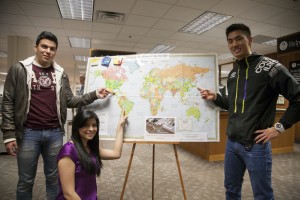BYU is found on top of two different lists addressing its number of Caucasian students compared to other universities, but some people say BYU’s campus is quite diverse.
The first list, titled “Colleges with the Highest Percentages of White Students,” has BYU ranked sixth in the nation with 94.28 percent. The second list, “Colleges with the Largest Enrollment of White Students,” puts BYU in 15th place with 20,292 white students.

Regardless, map and geographic information systems librarian Rick Grapes has done extensive traveling and says he considers BYU a diverse university.
“As a subset of LDS culture, BYU is ethnically diverse,” Grapes said. “Since BYU doesn’t have any government imposed racial quotas, we are actually quite diverse when compared to most colleges, especially the smaller community colleges, but when compared to the Ivy League schools, we are quite white, but that is not the result of any kind of imposed policies.”
A “diversity map,” created by the Science and Map Department of the Harold B. Lee Library, has been put up in different parts of the library for students to record the places they’ve lived in, visited or will go to on their missions. The creator of the map, Jed Johnston, works in the science and map desk at the library and came up with the map for two purposes. The first is to illustrate the department’s map collection.
“We’ve got a quarter of a million flat maps and even more resources online and in other formats too,” Johnston said.
The second purpose is to show how diverse BYU really is.
“BYU gets criticized quite a bit for not having a diverse group of students,” Johnston said. “And maybe just to look at us it’s true. There’s a lot of white Americans, but I think that hides some of the diversity we do have: diversity of experience.”
Jose Uribe, a former employee at the science and map desk and current physiology and developmental biology student, was born in Mexico City but grew up in different places around the world.
“I think that a university has to follow exactly what the name ‘university’ implies: universal,” Uribe said. “It has to do more with diverse ideas, cultural expressions and the overall exposure of the student body to the plethora of knowledge available, than to a geographical origin of the students.”
| Student Ethnicity | |
| As of Fall 2012, 14% of students are minorities | |
| Asian/Pacific Islander | 1,944 |
| Hispanic | 1,610 |
| Black | 254 |
| American Indian | 211 |
| Other/Multiethnicity | 488 |
| (BYU is restricted from requiring students to provide information about race; these figures are voluntary.) *Multiethnicity students do not show up in individual categories | |
The library’s map offers a visual demonstration of BYU’s diversity.
“Each one of those little dots represents a big experience in someone’s life story,” Johnston said. “Seeing the broad spread of those experiences on a map lets us visualize the richness of our collective story. I hope people see it and realize that if we make an effort to learn from each other while here at BYU, we’ll be able to absorb a world of experiences.”
For more information on the number of international students from each country, go to the International Services webpage.




